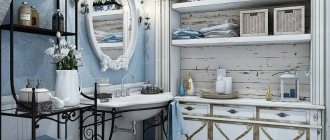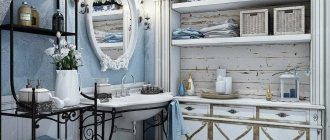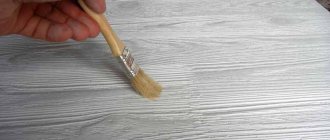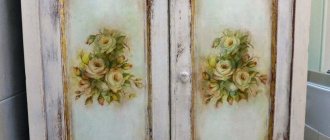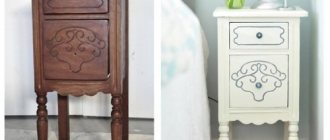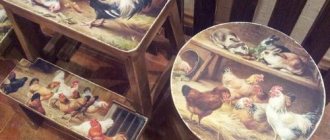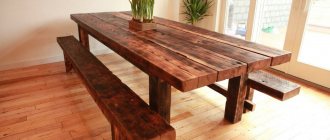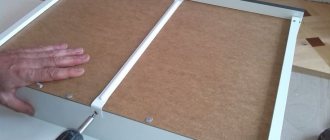Features of the Provence style
Provence is a more sophisticated analogue of American country. The style of the French countryside is distinguished by both simplicity and sophistication, elegance and modesty, an affinity for vintage furniture, naivety and idyllic tranquility. It is sincere and cozy, like a grandmother’s village house from childhood memories. It is especially common in kitchens, but can also decorate other rooms: living rooms, dining rooms, bedrooms.
Rare or antique furniture is very elegant and beautiful, but not everyone can afford this pleasure.
Style Features:
- Antique or artificially aged furniture.
- Natural flowers.
- Decoration with floral and rustic ornaments.
- An abundance of things from the “good old days,” from grandma’s box to antique trinkets bought at a flea market.
- Decoupage, sewing, ruffles and other handmade decor, made with your own hands.
- Softness, naturalness and variety of materials.
Slightly “faded” and dull colors, rustic but practical and high-quality things, rough plaster and natural textiles - this is interior design in the spirit of “French country”. There is no place for pomp, deliberate pretentiousness and arrogant luxury. The cold shine of metal, polished surfaces and modern furniture “monsters”-transformers are inappropriate. Everything is homely, cozy and modest, but at the same time subtly elegant.
Before you start aging furniture on your own, it is necessary to thoroughly prepare all wooden surfaces that will be processed.
Decor of Soviet furniture. How to get an ergonomic Provence style wardrobe in two days Bookmark 12
Who among us does not dream of a cozy, warm and stylish bedroom? I will probably be the first on the list of those who dream of a bright paradise for relaxation: with a book, a favorite movie, a blanket and cocoa. But, unfortunately, not everyone has the opportunity to have a separate bedroom, make repairs and buy furniture in the style they like.
Provence in interior design is the style of the province of France. It is distinguished by its special charm and coziness thanks to the abundance of light shades, interesting combinations (for example, a combination of light and dark wood), the use of “dusty” shades, aged wood and “patchwork” textiles. For me, this style is one of my favorites, because light furniture is what a person who grew up among the dark furniture of his parents’ “Khrushchev” apartments can dream of.
I think that almost everyone has this rich Soviet heritage: a huge dark brown wall, wardrobes, tables, chests of drawers, sideboards and dressing table. In general, hello from the 90s! Of course, such furniture has long gone out of fashion. It overloads the space, hardly fits into the interior, is “standard” (that is, the same for everyone), takes up a lot of space and is almost always inconvenient to use. But don't rush to throw away these long-livers. Let's look at the reason why you shouldn't get rid of Soviet furniture so soon.
The advantages of doing it yourself
Before we figure out how to paint furniture in the Provence style, how and in what ways to decorate it, let’s decide why this is needed at all. So, what are the advantages of restoring furniture and decorating a room in the spirit of the French countryside:
- Saving. Provence is much cheaper than classic, high-tech and most other styles.
- You don't even have to buy furniture. An existing one, artificially aged and restored, will do.
- Possibility of using old interior elements.
- Moral satisfaction, pride in what you have done with your own hands.
To make your furniture look shabby and worn, you can use the painting technique.
DIY furniture aging techniques
You can “age” a chest of drawers or sideboard in different ways. Let's look at the basic techniques.
Regular painting
- Preparatory stage: remove the old varnish with coarse-grain sandpaper, sand the surface with fine-grain paper.
- Painting. Pastel colors predominate in Provence. We choose the paint accordingly.
- Use iron wool (an abrasive material sold in hardware stores) to dry the surface until dark lines and spots appear.
- Paint the fittings with the same paint, dry, then clean with a wire brush.
New elements of fittings also need to be aged - after all, they can give away your trick with furniture.
Paint and paraffin
The aging effect can be achieved with ordinary paraffin. To do this, the coating is removed in some places with sandpaper. Then the working areas are rubbed with paraffin, and paint is sprayed on top using an aerosol can. It’s not scary if the coating is uneven - such negligence is quite consistent with the spirit of Provence.
The combination of a rich base and a light second layer will create the effect of faded paint.
Cleaning and bleaching
Whitening can be done either with a special whitening paste or by grinding. The paste is only suitable for porous wood. For example, oak or ash.
To consolidate the effect for a long time, coat the finished furniture with clear varnish.
Whitening:
- Thorough surface cleaning. Removing the varnish and sanding first with coarse sandpaper, then with finer-grain paper.
- The “aging” areas are covered with blue or brown paint, dried, and rubbed with paraffin.
- Paint the furniture by applying several layers of white paint.
If the base paint or wood is dark in color, use nitrocellulose varnish. For light breeds, a water-based varnish is suitable.
Patination at home
Patination can be carried out in dozens of ways and materials. At home, the easiest way is to purchase a patination composition. You can find it in any construction supermarket. First, the surface is prepared, painted, and varnished. We sand the dried furniture with 240-280 grit sandpaper. Then a patination preparation is sprayed onto the surface from a can. After this, the patina is removed with iron wool, remaining only in the recesses.
Patina appears on the surface as a result of many years of oxidation of paint, varnish or metal and is especially valued by connoisseurs.
Using craquelure varnish
Craquelure varnish is a varnish used to make craquelures. Unclear? It’s simple: craquelures are decorative cracks that create the effect of furniture cracked by time. The method is quite complicated and requires certain skills. Not for beginners.
Create an imitation spider web from cracks in an old protective coating on a dresser.
Interior decoration using French-style furniture
To create an atmosphere in this direction, wooden furniture, as well as forged iron parts, are most often used.
Modern interior details, which are made from new materials (glass, aluminum, chrome, etc.), are not at all suitable for this direction. And artificial materials that look like wood are well suited for painting products based on the theme of the Provençal province using delicate natural tones.
A wicker chair, a forged cornice, or furniture with some kind of ornament on it are good for this direction. In other words, any furniture that has the spirit of antiquity (an old chest of drawers or a chair, maybe even a chest) and has been standing for many years.
If you think about it, this style can be suitable for any room in the house, the most important thing here is to buy everything you need and be able to age objects yourself.
Creating such a design in any room combines comfort and ease of use.
What tools and materials will be needed
We will combine several techniques in one master class. To decorate furniture in the Provence style with your own hands, we will need the following tools and materials:
- Brushes, wide and narrower for “spot” painting.
- Acrylic water-based paint.
- Patination composition (in our case – bitumen varnish).
- Paraffin.
- Putty.
- Hairdryer (to speed up drying).
The set will depend on what kind of item is being aged and what method is used.
Result
My husband and I have plans to transform the space on a budget:
- thick linen curtains around the bed
- drawers for things and bedding in the bed without a removable mechanism (material - wooden fruit boxes and old dresser handles).
There is nothing more enjoyable than transforming a space with your own hands and to your taste. The main thing is not to be afraid of a limited budget or space. Repairs, children and a new life can be put off endlessly; there will always be no time. But I am sincerely confident that under any means and circumstances you can make something unusual, something that you like!
Step-by-step master class on aging furniture
- Applying a base coat of paint.
- Drying. You can use a hair dryer to speed up the process.
- Treatment of aging areas with paraffin.
- Adding putty for relief and creating the effect of a multi-layer coating.
- Creating a worn effect. This is achieved by friction with sandpaper, a stiff brush or iron wool... or by applying paint with a sponge, then the previous layer will be perceived as abrasion.
- Painting in several layers.
- Sanding.
- Patination.
- Drying.
After complete drying, you can begin sanding the area to be treated, then begin decorating.
If you have decorating skills, you can additionally paint furniture in the Provence style with your own hands. Floral ornaments and images with rural motifs will look especially organic.
You can use decoupage napkins with designs in the Provence style, which are transferred to furniture.
Restoration technique
Preparatory work
Anyone can learn to paint furniture with their own hands, since there is nothing complicated in the painting process. But properly preparing the base for painting is an entire art, and therefore it is worth dwelling on this issue in as much detail as possible.
We carry out the preparation work as follows:
- We disassemble the product, remembering or writing down what was attached where. We put all the bolts, nuts and screws separately.
- We remove everything that can be removed from the parts - moldings, handles, locks, hinges. We will restore metal products separately, removing rust and repolishing them.
- We inspect the wooden parts, paying special attention to the condition of the front surfaces.
We sand small parts as shown in the photo.
- If necessary, remove the layer of old paint by heating it with a hairdryer or pre-treating it with removers. We do the same with old varnish.
Advice! By heating, you can remove not only paint, but also plastic, and even veneer.
- If the surface condition is satisfactory, then sand the part using medium-grit sandpaper. Our task is to reveal all defects and remove the top layer of paint and varnish material.
- Flat areas can be sanded, but a sanding sponge is best for high spots and low spots.
- After the initial sanding, we take wood putty and smooth out all the defects. We also fill cracks and cracks with putty, paying special attention to the ends of the facades and walls.
Eliminating defects with putty
- Let the putty dry (the instructions should contain information about the technology and drying time). After this, we perform final grinding using a fine abrasive. We collect the dust formed during the sanding process with a vacuum cleaner or a damp sponge.
The final stage of preparation is primer. Apply the primer with a wide brush, in two passes with mandatory intermediate drying. (See also the article Priming walls for putty: features.)
Coloring
The process of painting furniture is quite simple:
- First, we test the composition in a small area. It is advisable to choose a part that, after installation, will face the wall.
- If the testing was successful, apply the paint with a roller or spray to all surfaces.
Apply a base coat from a spray bottle
Advice! You can use polyethylene or masking tape to protect areas from paint. The second option is also convenient because such tape does not leave marks on surfaces.
- After the first layer has dried, we evaluate the quality of the surface. If necessary, we sand areas with defects or apply putty.
- Apply a second coat of paint, trying to fill all the gaps in the base coat. After this, we dry the part and then varnish it.
- If you plan to paint in two colors, then before varnishing, remove the masking tape, re-glue it to the required places and repeat the operations.
Advice! First we apply lighter shades, and then darker ones: this way the paint lying on top will not show through.
- Instead of regular varnishing, you can also decorate the product in a variety of ways. We will talk about some of them in the next section.
Decoration technologies
Plain furniture fronts look quite attractive, but still somewhat boring.
Ready-made examples of aging different furniture with your own hands
The chest of drawers “aged” using the reverse patination method looks good. In this case, abrasions are achieved not by rubbing off the patina, but by rubbing away the underlying layer of paint.
An old Soviet cabinet restored in Provence style with an attached additional storage system in the form of a bookcase.
If the work is done correctly and in compliance with the appropriate instructions, furniture made in this style will give the room a feeling of comfort and coziness.
Rack and shelf, aged with patina.
Provence creates a lovely homely coziness and a comfortable indoor environment.
In addition to aging furniture, the Provence style can always be complemented by decoration using decoupage techniques and other types of painting. Antique trinkets, handmade souvenirs, and fresh flowers will look great in this interior.
Any antique item can be restored, repainted and given a decorative role in the Provence style.
How to make aged furniture (with photos)
One of the accessible and very effective ways to age furniture with your own hands is to create scuffs. What and how to make them - read below.
We paint the surface of the furniture loosely so that the bottom layer of paint is visible - this is the easiest way to create scuffs. The best result will be achieved if the paint color contrasts with the color of the furniture surface.
Another way to achieve scuff marks is to use a combination of different colors when painting, as well as waxing and artificial scraping.
For this method you will need wax sticks or paraffin candles. Paraffin candles should be simple, domestically produced, unpainted.
Scuffs are made on the surface of the furniture, decorating it and creating the patina of time.
Look at the photos of aged furniture to see how well it fits into various residential interiors:
